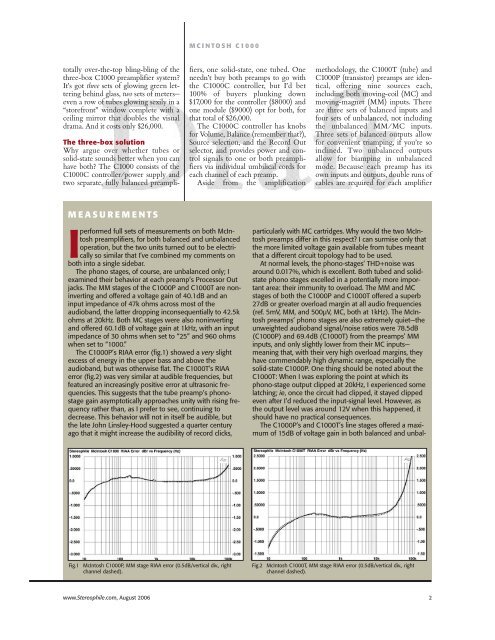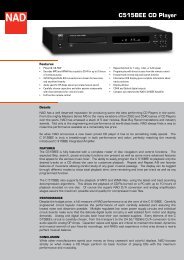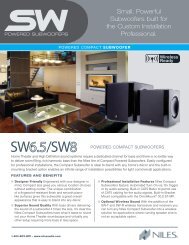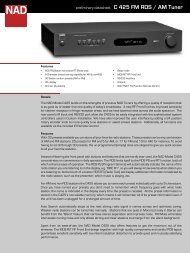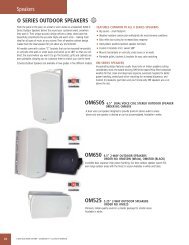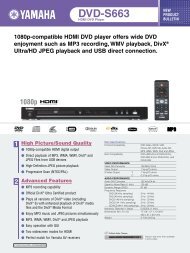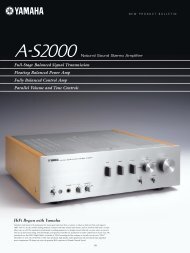McIntosh C1000 Stereophile Review - The Listening Post
McIntosh C1000 Stereophile Review - The Listening Post
McIntosh C1000 Stereophile Review - The Listening Post
Create successful ePaper yourself
Turn your PDF publications into a flip-book with our unique Google optimized e-Paper software.
MCINTOSH <strong>C1000</strong>totally over-the-top bling-bling of thethree-box <strong>C1000</strong> preamplifier system?It’s got three sets of glowing green letteringbehind glass, two sets of meters—even a row of tubes glowing sexily in a“storefront” window complete with aceiling mirror that doubles the visualdrama. And it costs only $26,000.<strong>The</strong> three-box solutionWhy argue over whether tubes orsolid-state sounds better when you canhave both? <strong>The</strong> <strong>C1000</strong> consists of the<strong>C1000</strong>C controller/power supply andtwo separate, fully balanced preamplifiers,one solid-state, one tubed. Oneneedn’t buy both preamps to go withthe <strong>C1000</strong>C controller, but I’d bet100% of buyers plunking down$17,000 for the controller ($8000) andone module ($9000) opt for both, forthat total of $26,000.<strong>The</strong> <strong>C1000</strong>C controller has knobsfor Volume, Balance (remember that?),Source selection, and the Record Outselector, and provides power and controlsignals to one or both preamplifiersvia individual umbilical cords foreach channel of each preamp.Aside from the amplificationmethodology, the <strong>C1000</strong>T (tube) and<strong>C1000</strong>P (transistor) preamps are identical,offering nine sources each,including both moving-coil (MC) andmoving-magnet (MM) inputs. <strong>The</strong>reare three sets of balanced inputs andfour sets of unbalanced, not includingthe unbalanced MM/MC inputs.Three sets of balanced outputs allowfor convenient triamping, if you’re soinclined. Two unbalanced outputsallow for biamping in unbalancedmode. Because each preamp has itsown inputs and outputs, double runs ofcables are required for each amplifierMEASUREMENTSIperformed full sets of measurements on both <strong>McIntosh</strong>preamplifiers, for both balanced and unbalancedoperation, but the two units turned out to be electricallyso similar that I’ve combined my comments onboth into a single sidebar.<strong>The</strong> phono stages, of course, are unbalanced only; Iexamined their behavior at each preamp’s Processor Outjacks. <strong>The</strong> MM stages of the <strong>C1000</strong>P and <strong>C1000</strong>T are noninvertingand offered a voltage gain of 40.1dB and aninput impedance of 47k ohms across most of theaudioband, the latter dropping inconsequentially to 42.5kohms at 20kHz. Both MC stages were also noninvertingand offered 60.1dB of voltage gain at 1kHz, with an inputimpedance of 30 ohms when set to “25” and 960 ohmswhen set to “1000.”<strong>The</strong> <strong>C1000</strong>P’s RIAA error (fig.1) showed a very slightexcess of energy in the upper bass and above theaudioband, but was otherwise flat. <strong>The</strong> <strong>C1000</strong>T’s RIAAerror (fig.2) was very similar at audible frequencies, butfeatured an increasingly positive error at ultrasonic frequencies.This suggests that the tube preamp’s phonostagegain asymptotically approaches unity with rising frequencyrather than, as I prefer to see, continuing todecrease. This behavior will not in itself be audible, butthe late John Linsley-Hood suggested a quarter centuryago that it might increase the audibility of record clicks,particularly with MC cartridges. Why would the two <strong>McIntosh</strong>preamps differ in this respect? I can surmise only thatthe more limited voltage gain available from tubes meantthat a different circuit topology had to be used.At normal levels, the phono-stages’ THD+noise wasaround 0.017%, which is excellent. Both tubed and solidstatephono stages excelled in a potentially more importantarea: their immunity to overload. <strong>The</strong> MM and MCstages of both the <strong>C1000</strong>P and <strong>C1000</strong>T offered a superb27dB or greater overload margin at all audio frequencies(ref. 5mV, MM, and 500µV, MC, both at 1kHz). <strong>The</strong> <strong>McIntosh</strong>preamps’ phono stages are also extremely quiet—theunweighted audioband signal/noise ratios were 78.5dB(<strong>C1000</strong>P) and 69.4dB (<strong>C1000</strong>T) from the preamps’ MMinputs, and only slightly lower from their MC inputs—meaning that, with their very high overload margins, theyhave commendably high dynamic range, especially thesolid-state <strong>C1000</strong>P. One thing should be noted about the<strong>C1000</strong>T: When I was exploring the point at which itsphono-stage output clipped at 20kHz, I experienced somelatching; ie, once the circuit had clipped, it stayed clippedeven after I’d reduced the input-signal level. However, asthe output level was around 12V when this happened, itshould have no practical consequences.<strong>The</strong> <strong>C1000</strong>P’s and <strong>C1000</strong>T’s line stages offered a maximumof 15dB of voltage gain in both balanced and unbal-Fig.1<strong>McIntosh</strong> <strong>C1000</strong>P, MM stage RIAA error (0.5dB/vertical div., rightchannel dashed).Fig.2<strong>McIntosh</strong> <strong>C1000</strong>T, MM stage RIAA error (0.5dB/vertical div., rightchannel dashed).www.<strong>Stereophile</strong>.com, August 2006 2


